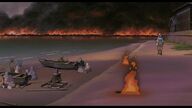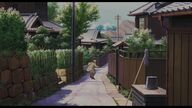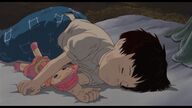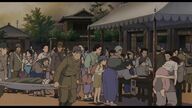The animation works of Studio Ghibli seem to have pure fantasy colors, the naive Chinchilla, the cute trainee witch Kiki, the cat who knows how to repay, and the goldfish princess living on the cliff. It can be said that everyone loves it. A typical representative for all ages. But looking through Studio Ghibli's worksheets, there is a different animation, the story takes place in the brutal war years, and the tragic end is foretold at the beginning. This may also be the most controversial animation of Studio Ghibli. People are not only moved by the sincere brother and sister relationship in the film, but also question its historical view and value orientation. In this issue of used projectors, let's walk into "Grave of Fireflies" together and into the world of Supervision Takahata Isao.
In the previous program about "My Neighbor Totoro", we mentioned that after the "My Neighbor Totoro" project was rejected, Toshio Suzuki came up with the idea of "Takahata Isao + Miyazaki making animation at the same time", which can create a topical idea, In addition, Sato Ryoichi, the president of Shinchosha at the time, hoped that the company could not only do book publishing business, but also distribute as many literary and artistic works as possible. This changed the thinking of the high-level, allowing "My Neighbor Totoro" and "Grave of Fireflies" to get the opportunity to meet the audience.
However, the production of these two works was not particularly smooth. On the one hand, the newly established Studio Ghibli had to undertake the workload of the two projects at the same time. On the other hand, Isao Takahata is not a supervisor who can accurately control the time and budget. His old partner Toshio Suzuki once said, "Although Takahata Isao can control the budget very well when he is a producer, when he is a director, he will spend his budget to the fullest." The animation originally scheduled for about 60 minutes was forced to 90 minutes by the supervision of Takahata Isao, which also forced the "My Neighbor Totoro" production team to make adjustments in terms of duration. Studio Ghibli is famous for its attention to detail. As one of the founders, Supervisor Takahata Isao naturally follows this style of work. How strict is he? Even the direction of the US bomber's air strikes in the animation was made after research. Supervisor Takahata experienced the Okayama air raid when he was a child. He called that experience "the worst nightmare in my life", and this experience was truthfully reflected in "Grave of Fireflies". Due to the construction period, "Grave of the Fireflies" was not released on time, and there were even two blanks in the screen during the first round of screenings. The audience did not see the completed version of "Grave of the Fireflies" until the second round of screenings. The box office is also very bleak, and the combined revenue of the two films that are packaged and released at the same time is less than 600 million yen. Toshio Suzuki said bluntly: This is the worst box office in film history.
"Grave of the Fireflies" is a controversial animation. It is based on the background of an unjust war of aggression and tells the miserable life of ordinary people on the side of the country that harms them. This will inevitably make some viewers feel very uncomfortable. Some commentators believe that "Grave of Fireflies" seems to be more like a "anti-war defeat" work than a reflection and review of the war. But such an interpretation is not the original intention of the supervisor of Takahata Xun. Takahata Xun is a staunch anti-war activist who advocates fairness and freedom.
When Japanese Prime Minister Shinzo Abe planned to make changes to Article 9 of the constitution in 2013, he and Miyazaki also wrote critical articles in the Studio Ghibli publication "Hot Wind." Here's a little story, enough to support his political stance: Before making "A Fairy Tale of the Years," Isao Takahata had expected to adapt the novel "Kingdom," about the "Manchuria" under Japanese colonial rule, into an animation. country”, a story with ordinary Japanese people who are unaware of the act of aggression. Takahata Isao hopes that through this work, the entire Japanese society can understand the history of the war of aggression and become aware of taking responsibility for the harm. But the plan aborted when preparations were over. Therefore, we can believe that, as the creator, he did not make "Grave of Fireflies" with the purpose of remorse for defeat or reversing black and white.
What is the purpose of the overseer? A poorly translated script outline of "Grave of the Fireflies" can be found on the Internet. The general idea is that in an era when the relationship between people is getting colder, disasters will destroy the trust relationship of human beings and expose their greedy nature. . There are very few people who can always protect their sister like Seita. Since the original text has not been found, it is only for reference here. Takahata said: "Today, the relationship between family and neighbors has become more and more thin. Instead, we are protected by different classes under social constraints. We regard non-interference as the bottom line of a relationship. Inconsequential considerations show kindness to others. There is no need for a war, as long as a natural disaster strikes and destroys the restraints of society and loses the idea of mutual help and cooperation among people, then people will not be able to be in natural relationship with others Avoid revealing its greedy nature. It makes me think I can be on either side. Even if one side tries to escape the human circle to live alone with his sister, how many boys, or humans, can keep guarding their own Sister is as old as Seita? But in interviews with various media, the supervisor continued to talk about his thoughts and thoughts when he was making "Grave of Fireflies". This has also become an outlet for us to explore Takahata Isao's original intention.
In an interview with the Kanagawa Shimbun in 2015, Superintendent Takahata Isao described his understanding of "anti-war movies". He believes that the purpose of anti-war movies is to prevent wars from happening again, and "Grave of the Fireflies" has no such effect. Once the ruler chooses to go to war, the reason for "avoiding a repeat of the tragic events in the movie" can be used to incite the masses. During the production, he never used "Grave of the Fireflies" as a propaganda method for Japanese peace education, but wanted to use the story of Seita and Setsuko breaking away from the social group and wanting to establish a life of a two-person family. It alludes to some phenomena in society, especially for some young people in their twenties. Therefore, during the production, Takahata Isao deliberately made the image of Qingta move closer to the direction of modern teenagers. We will find that compared to the other protagonists of Studio Ghibli, Qingta's setting is not positive enough. He couldn't bear the hardship. When threatened by his aunt to eat separately, he showed reassurance and calmness. He thought it was easier to support himself than to endure his aunt's discrimination. As a result, his life with his sister became more and more difficult, and in the later period he could only survive by stealing things. In Takahata Isao's view, such emotions are closer to those of modern children. But this is not to say that Supervision Takahata Isao has much opinion on the young people of today's era. As a creator, he has a partial positive attitude towards the role of Seita. We will introduce this in detail later.
In the May 1988 issue of "Animage", Superintendent Takahata Isao shared his understanding of the entire story. "Grave of Fireflies" takes building a family as the premise of the story. In the case of his father's death in the war, Qingtai and his sister Setsuko formed the smallest unit of "family". on track. Although they did not deal with the daily trivialities of food, clothing, housing and transportation, and both brothers and sisters passed away, their lives were surrounded by love. Therefore, according to Takahata Isao, the family life of Seita and Setsuko was successful. And this tragedy of being unable to save my sister's life even with a successful family life is the embodiment of the myth of "Grave of the Fireflies".
The opposite of a successful family life is the social life of Seita and Setsuko. On the one hand, the adults around the protagonist are too indifferent, and on the other hand, Seita is constantly giving up the opportunity to establish relationships with other people. He does not go to school, does not consult with teachers, and refuses to associate with relatives he does not like. Takahata Xun believes that the life of modern people is also the same. People take family as the core, avoid contact with those who cannot tolerate as much as possible, and live in their own little world. As stated in the plot synopsis, the relationship between people is thinning.
On the other hand, Seita and Setsuko lived in an era of repressed "groupism" control, which was completely different from today's advocacy of individualization. At that time, organizations with a groupist style such as the Patriotic Women's Association and the Industrial News Congress dominated the entire the rhythm of society. Qingtai is nothing but a rebel. He is eager to escape from groupism and build a family of his own. From the perspective of the past, Qingtai's behavior is typically anti-social. But today is different from the past. It is precisely because Qingtai's thinking circuit is very suitable for modern people's thinking that the audience will empathize with him. Here, Superintendent Takahata Isao raised a question: If the wind of the times is reversed, will we support Seita's actions as we do now? Will it succumb to groupism? Thinking of the possible answers, Director Takahata Isao couldn't help but shudder.
The real "Grave of Fireflies" is different from the original novel and animation. According to the original author Nosaka Akira, as the only survivor, he felt guilty for his sister's death. While looking for food, he often fills his belly before feeding his sister. My sister is undoubtedly hungry. And it is this tragic fact that has kept him from extricating himself for many years. Prompted him to write about the experience in the hope that the demons would not torture him again.
But no matter how you look at it, there is indeed a discrepancy between the information that Supervision Takahata wants to convey and the audience's understanding. People still pay more attention to the cruelty of war and the touching brother-sister relationship. Therefore, every time the marketing account selects the "Top Ten Tear-Jerking Animations", we can always see the figure of "Grave of Fireflies". After the animation was released, Supervisor Takahata was expected to have voices criticizing Qingtai's character, but his sympathy for Qingtai had the upper hand in the feedback from the audience at that time. This also reflects Takahata Isao's ability in character building and emotional scheduling: because the feelings between the characters are too sincere, we have no time to pay attention to other content. However, in the past ten years, there have been voices criticizing Qingtai in the comments of any country. Some viewers think that Qingtai is self-inflicted. He is used to the life of opening his mouth in the past. Even if the situation is worse than before, he does not want to pass himself. labor to create any value. This also makes people re-examine the film "Grave of the Fireflies". What Supervision Takahata Isao wants to express is by no means as simple as it seems.
As Chinese audiences, our feelings about Grave of the Fireflies are more mixed because we know better than anyone what that war really means. Perhaps his existence is to remind us to remember this history.
View more about Grave of the Fireflies reviews








